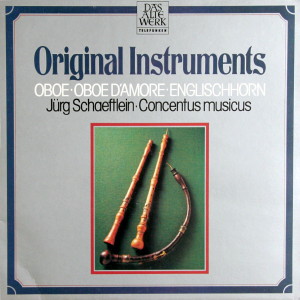 |
1 LP -
6.42110 AP - (p) 1977
|
|
| Original Instruments - Oboe,
Oboe d'amore, Englischhorn |
|
|
|
|
|
|
|
| Georg Friedrick Händel
(1685-1759) |
|
|
|
Concerto g-moll, Hwv 287
|
|
8' 37" |
A1 |
| für Oboe, Streicher und B.c.
(Violoncello, Violone, Cembalo) |
|
|
|
| - Grave |
2' 32" |
|
|
| - Allegro |
1' 52" |
|
|
| - Sarabande, Largo |
2' 15" |
|
|
| - Allegro |
1' 58" |
|
|
|
|
|
|
| Antonio Vivaldi
(1678-1741) |
|
|
|
| Concerto a-moll (F. VII/13)
(P. 89) |
|
9' 27" |
A2 |
| für Oboe, Streicher und B.c.
(Violoncello, Violone, Cembalo) |
|
|
|
| - Allegro |
3' 25" |
|
|
- Largo
|
3' 07" |
|
|
| - Allegro |
2' 55" |
|
|
|
|
|
|
| Johann Sebastian Bach
(1685-1750) |
|
|
|
| Konzert für Oboe d'amore,
Streicher und B.c. (Violoncello,
Violone, Cembalo) A-dur |
|
14' 02" |
B1 |
| (Rekonstruktion nach dem
Cembalokonzert BWV 1055) |
|
|
|
- (Allegro)
|
4' 38"
|
|
|
| - Larghetto |
5' 09" |
|
|
- Allegro ma non tanto
|
4' 15" |
|
|
|
|
|
|
| Wolfgang Amadeus Mozart
(1756-1791) |
|
|
|
| Adagio C-dur, KV 580a |
|
4' 34" |
B2 |
| für Englishhorn, 2 Violinen und
Violoncello - (Ergänzt von Herbert
Tachezi) |
|
|
|
|
|
|
|
Jürg Schaeftlein, Oboe,
Oboe d'amore, Englishhorn
|
|
|
|
| Händel - Vivaldi - Bach |
Mozart |
|
| CONCENTUS
MUSICUS WIEN (mit
Originalinstrumenten) |
Jürg
Schaeftlein, Englishhorn |
|
| Nikolaus
Harnoncourt, Leitung |
Alice
Harnoncourt, Violine |
|
|
Walter
Pfeiffer, Violine |
|
|
Nikolaus
Harnoncourt, Violoncello |
|
|
Luogo
e data di registrazione
|
1976
(Mozart)
|
|
Registrazione
live / studio
|
| studio |
Producer
/ Engineer
|
-
|
Prima Edizione CD
|
-
|
Prima
Edizione LP
|
Telefunken "Das
Alte Werk" - 6.42110 AP
- (1 lp) - 36'
40"
- (p) 1977
|
|
Note
|
La registrazione del Concerto
di Händel è la stessa già edita nel 1974
Telefunken
SAWT 9618-A.
La registrazione del Concerto
di Vivaldi è la stessa già edita nel
1976 Telefunken
6.41961 AW.
La registrazione del Concerto
di Bach è la stessa già edita nel 1977 Telefunken 6.42032 AW.
|
|
|
Notes on the
performance
|
Most
European musical instruments
originate from the orient.
The shawm
too,
with its double reed,
conical tube and flared bell
section reached Europe in
the course of Islamic
wanderings, turning up there
in the 12th century at the
latest. In the l6th century
the shawm was built up into
an entire family, comprising
small, high, large and deep
members, from which were
developed about a dozen
variants. In the first half of the
17th century the
deep shawms and the variants
disappeared from performance
practice. What remained was
the discant shawm, which was
developed in France around
the middle of the century
into an instrument known in
French as hautbois (= high
wood). The Italians
phonetically transformed
this word into oboe, which
then turned into oboe in
German.
The basic key scale of the
oboe is D major. By way of a
key for
c’ the range is extended
downwards by one note. The
chromatic notes come about
by half covering
or crossfingering,
and only for e’ - flat there
are two keys for the little
fingers,
one left and the other
right, since up to the
middle of the l8th century
performers held either the
left or the right hand
downwards.
In the 18th century the oboe
was again expanded into a
little family. Around l720
the oboe d’amore or
“Liebesoboe" in A was
evolved, i.e. transposed
downwards a minor third,
with a straight tube and a
pear-shaped foot
(Liebesfuss) which gives the
instrument a softer
tone. The method of playing
is the same as with the
oboe. The concerto by J. S.
Bach played on this record
has been preserved as a
piano concerto, but actually
is an arrangement of a score
which has been mislaid for a different
solo instrument. It is
played here on an oboe
d’amore made by Johann
Wilhelm Oberlender, also of
Nuremberg. Oberlender’s son
later took over Jacob
Denner’s workshop.
In the same century several
forms of oboes in F emerged,
transposed a fifth lower and
bearing various names. One
of these at first
had a curved tube with a
leather covering (which was
later bent) and also had a
“Liebesfuss”. Its confusing
name was the English horn.
The instrument used in this
recording made by J. Baur of
Vienna dates back to the
second half of the century,
when the right hand was
still being used in the
downward position, so that
only one e’ - flat key to
the right
still exists. In 1789
Mozart composed for an
instrument of this
klnd the Adagio for English
horn and three accompanying parts
which were not more clearly
specified.
John
Henry van der Meer
English
translations by Frederick
A. Bishop
|
|
Nikolaus
Harnoncourt (1929-2016)
|

|

|
|

